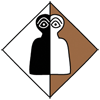Occupational History
5th/4th Millennia BC
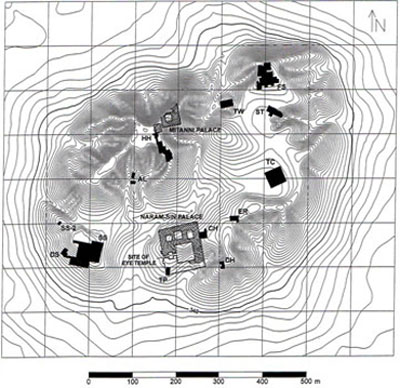
EDM tell plan, one metre intervals, showing major areas of excavation
(click to enlarge).
Plan courtesy G. Emberling, T. Skuldbøl & T. Larsen.
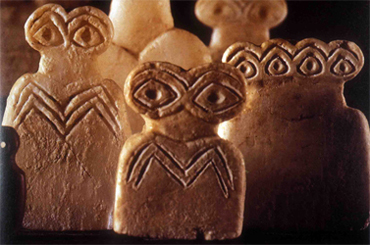
Eye Idol figurine group
The earliest levels excavated so far date to the mid-5th millennium
BC (Late ‘Ubaid and Late Chalcolithic 1) in Area CH. These
levels, to
be published in Brak Vol. 3 (forthcoming), had been much
disturbed by
the construction of later monumental buildings. However, the evidence
suggests that there were monumental buildings in this area at least as
early as the end of the Ubaid Period.
Better-preserved evidence for the early city has been found in Area
TW, where an uninterrupted sequence from the late 5th (LC2) to the
early 3rd millennium BC has been excavated. This sequence of occupation
includes unparalleled monumental buildings of late 5th and early 4th
millennia BC date (LC2) followed by evidence for a south Mesopotamian
Late Uruk colony.
An industrial area adjacent to the late 5th millennium BC monumental
building is one focus of the current
research programme. Material of the 4th millennium BC has also been
identified on the Area HS ridge, and much of the 90-hectare Outer Town
(outside the limits of the tell itself) is first occupied at this time.
Undoubtedly the best-known building of this date is the Eye
Temple, excavated by Mallowan in the 1930s. Our recent excavations
now enable us to date more precisely the original version of this
building to the first half of the 4th millennium BC.
Together, the evidence for large size, religious and secular
authorities, and economic complexity imply that Brak was a city by the
early 4th millennium BC, or c 3800 BC.
3rd Millennium BC
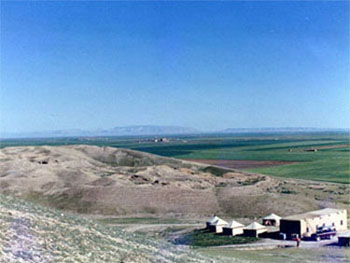
Area of Naram-Sin Palace, seen from Area HH, with Jebel Sinjar and its
western pass in the distance.
Brak remained urban in size and complexity during the 3rd millennium
BC but retracted back to the limits of the main central mound. Houses
belonging to the 3rd millennium city have been excavated on both
northern (Area HS) and southern (Area CH) portions of the
tell. And in
1999-2004, part of a large public building was investigated in Area
TC.
Of particular importance for the late 3rd millennium Akkadian Period
was Mallowan’s excavation of the ‘Palace’ (actually a fortified
storehouse) of Naram-Sin, a grandson of Sargon of Agade. This building
provided the first known evidence for South Mesopotamian control in the
area. During the 1980s-90s, further important early Akkadian Period
buildings were investigated, including a unique audience hall and
temple together with administrative and ‘industrial’ areas near the
Naram-Sin Palace (Area SS), and a temple and possible ‘way
station’
near the north gate of the city (Area FS). Cuneiform tablets and
sealed
bullae from these buildings tell us something of the Akkadian and later
administration.
Of significance is the evidence for more or less continuous
occupation throughout the 3rd millennium BC, including an apparently
Hurrian rebuilding of the Naram-Sin building, squatter occupation in
Area SS, and further use of the site’s northern ridge. Evidence from
Tell Leilan suggests abrupt climate change and an abandonment of that
site and adjustments to the settlement pattern across the region, but
the inhabitants of Brak proved more resilient or adaptable.
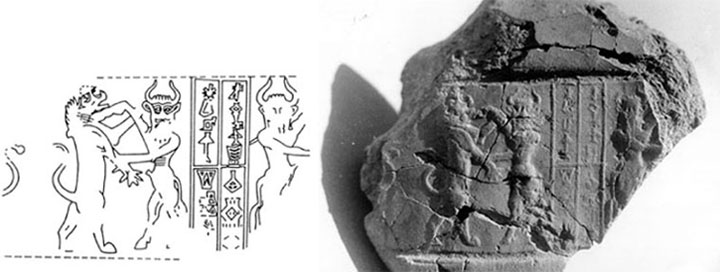
Sealing of late 3rd millennium Hurrian ruler, “Talpuš-atali, sun of the
country of Nagar”.
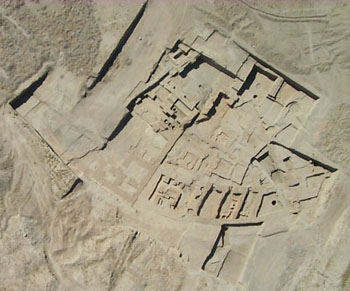
Kite photograph of Area TC. Photo by Evan Malone (with permission of
Geoff Emberling).
2nd Millennium BC
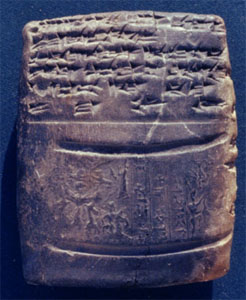
Reverse of a legal document sworn in the presence of the Mitanni king
Tušratta, one of the royal participants in the famous Amarna
correspondence (14th century BC).
Around 1950 BC, there was a change in occupation at the site and in
the Upper Khabur region, apparently coinciding with the settlement of
recently-arrived tribal Amorites. This new phase was signaled
archaeologically by the presence of so-called Khabur ware, a painted
pottery type first found (and named) by Mallowan. Occupation on the
mound at Brak was limited at this time, reduced to the northern part of
the tell which, as a result, has become its highest part.
The site remained relatively small and restricted to the northern
ridge during the later 2nd millennium BC Mitanni Period, although a
supplemental ‘suburb’ developed in the northern Outer Town. Mallowan
excavated Mitanni houses in Area HH, and in the late 1980s David Oates
excavated the Mitanni Palace and adjacent temple.
Further houses of Old Babylonian through Mitanni date were exposed
during 2006-2011. The town landscape and material culture of the
terminal 3rd through 2nd millennia BC is a current
focus of research at
the site. This project includes investigation of the little-understood
transition from Early to Middle Bronze (c. 1950 BC), marked in the
region by settlement pattern change and possible environmental
breakdown. It also comprises exploration of the continuity of domestic
space use on the site during the political shifts from the territorial
state of Samsi-Addu through its collapse and the imposition of the
Mitanni state. The latest surviving occupation on the main tell is of
Middle Assyrian date.
1st Millennium BC and later
The final settlement of Brak, including Roman and early Islamic, is
found largely in the Outer Town, though there may have been a Late
Assyrian temple on the north part of the tell, as suggested by the
recovery of two Late Assyrian baked clay ‘hands of Ishtar’.


